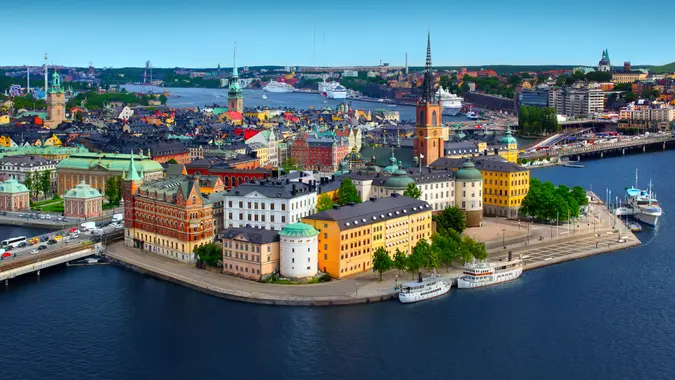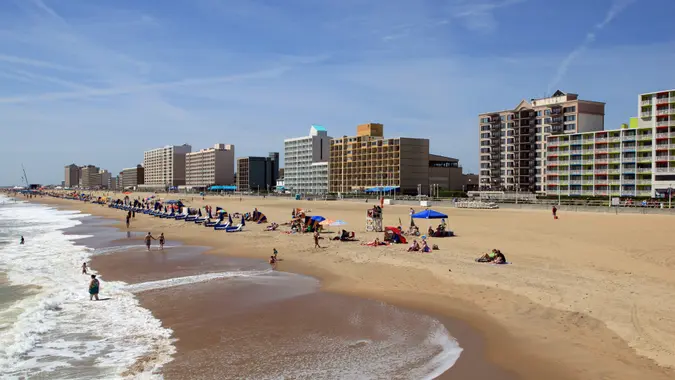How Much You Need To Retire Abroad in These 3 Scandinavian Cities

Commitment to Our Readers
GOBankingRates' editorial team is committed to bringing you unbiased reviews and information. We use data-driven methodologies to evaluate financial products and services - our reviews and ratings are not influenced by advertisers. You can read more about our editorial guidelines and our products and services review methodology.

20 Years
Helping You Live Richer

Reviewed
by Experts

Trusted by
Millions of Readers
As more individuals seek a fresh start in destinations that blend strong community ties, breathtaking landscapes and excellent healthcare, Scandinavian capitals like Stockholm, Oslo and Copenhagen have become appealing choices.
Known for their high-quality lifestyle, efficient public services and robust healthcare systems, these vibrant cities offer an ideal setting for a fulfilling retirement. The widespread use of English also makes the transition smoother for newcomers.
While living costs in Scandinavia can sometimes be lower than in the U.S., expenses vary greatly by country. Sweden remains the most affordable option, while Denmark and Norway are typically more expensive, particularly in urban areas.
Securing a comfortable lifestyle during your golden years in Scandinavia requires thoughtful financial planning. Data from Numbeo, the world’s largest crowd-sourced database for global living conditions and cost indexes, provides a detailed look at the estimated monthly expenses in these iconic Northern European capitals, including insights into the costs for both singles and couples.
If you don’t see yourself settling in Europe for retirement, consider these options in the U.S. that feel like Europeans hotspots.
1. Stockholm, Sweden
Stockholm offers a balanced cost of living. Residents will find that housing, groceries and healthcare are generally more affordable than in the U.S.
- Housing: Renting a one-bedroom in Stockholm’s city center averages $1,300 per month; outside the center, it’s around $900. Property prices in central Stockholm are about $6,000 per square meter.
- Groceries and dining: Monthly grocery costs range from $300 to $400. A mid-range restaurant meal costs $15 to $20, while a three-course dinner for two averages $75.
- Healthcare: The system is largely tax-funded, with annual fees capped at $105 for residents. Private insurance for non-residents typically costs $100 to $200 per month.
- Transportation: A monthly public transit pass costs about $90, and regional train tickets range from $100 to $125.
- Estimated monthly budget: Expect to budget between $2,200 and $3,200 per month for a comfortable lifestyle.
2. Oslo, Norway
Oslo provides a well-rounded cost of living. While housing and dining tend to be on the higher side, healthcare and transportation are generally less expensive than in many major U.S. cities, offering a favorable balance for residents.
- Housing: Rent for a one-bedroom apartment in Oslo’s city center averages $1,500 per month, while outside the center, it drops to about $1,000. Property prices in the central area are roughly $7,500 per square meter.
- Groceries and dining: Monthly grocery expenses typically range from $350 to $450. Dining at a mid-range restaurant costs $20 to $25 per meal, while a three-course dinner for two is about $90.
- Healthcare: Norway’s healthcare system is publicly funded, with annual fees capped at around $250 for residents. Private insurance for non-residents ranges from $150 to $250 per month.
- Transportation: A monthly public transit pass in Oslo costs about $100. Regional train tickets range from $120 to $150.
- Estimated monthly budget: A comfortable lifestyle in Oslo requires a budget between $2,800 and $3,800 per month, depending on personal preferences.
3. Copenhagen, Denmark
Copenhagen offers an exceptional quality of life, but housing and grocery expenses can be higher, reflecting the city’s status as a culinary hotspot and vibrant urban center.
- Housing: Renting a one-bedroom apartment in the city center averages $1,700 per month, while outside the city center, it’s closer to $1,200. Property prices in central Copenhagen are around $7,500 per square meter.
- Groceries and dining: Expect monthly grocery costs to be between $400 and $500. A mid-range restaurant meal costs $20 to $25, while a three-course dinner for two averages about $100.
- Healthcare: Denmark’s healthcare system is primarily tax-funded, offering comprehensive public services. For non-residents, private insurance usually costs between $150 and $250 per month.
- Transportation: A monthly public transit pass costs around $100, while regional train tickets range from $125 to $150.
- Estimated monthly budget: Depending on lifestyle preferences, the monthly budget is estimated to be between $2,800 and $4,000 for a comfortable living standard.
 Written by
Written by  Edited by
Edited by 

























